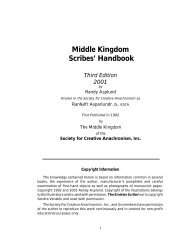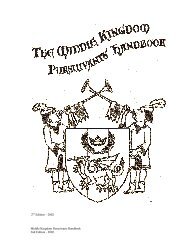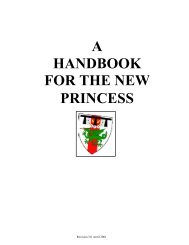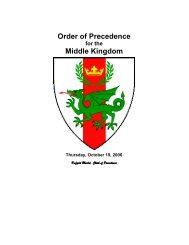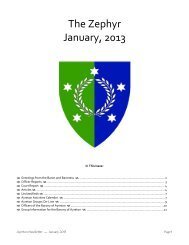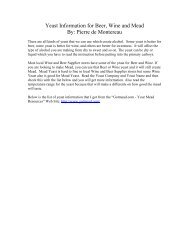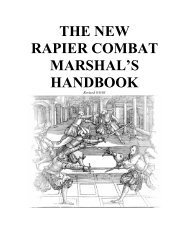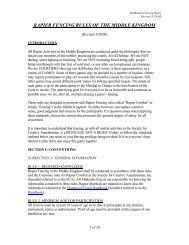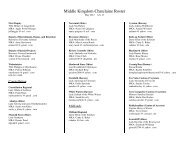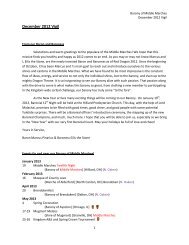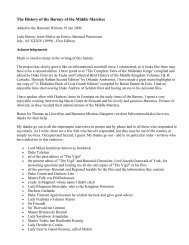Making Early Period Anglo-Saxon Garb - Midrealm / Middle Kingdom
Making Early Period Anglo-Saxon Garb - Midrealm / Middle Kingdom
Making Early Period Anglo-Saxon Garb - Midrealm / Middle Kingdom
You also want an ePaper? Increase the reach of your titles
YUMPU automatically turns print PDFs into web optimized ePapers that Google loves.
<strong>Making</strong> <strong>Early</strong> <strong>Period</strong><br />
<strong>Anglo</strong>-<strong>Saxon</strong> <strong>Garb</strong><br />
By: Pierre de Montereau
<strong>Making</strong> <strong>Early</strong> <strong>Period</strong> <strong>Anglo</strong>-<strong>Saxon</strong> <strong>Garb</strong><br />
Women<br />
General Information<br />
The common women’s garb included the sleeved inner gown, peplos, stockings, knee<br />
garters, belt, cloaks, bead(s) string, shoes, knife, pouches and purses, brooches and other<br />
tools that they carry on or work with including wood cards for tablet weaving, drop<br />
spindle, etc.<br />
For the loincloth and/or briaes, all the documents said that the ladies do not wear them.<br />
Archaeology finds <strong>Anglo</strong>-<strong>Saxon</strong> dig sites and they cannot find any proof that the women<br />
ware loincloths and/or briaes because most of the garment only have small parts of fabric<br />
which are touching metal objects that are preserved so they cannot be confirmed or<br />
denied. Now women use undergarments so I believe that in <strong>Early</strong> <strong>Anglo</strong>-<strong>Saxon</strong> times<br />
they used some sort of loincloth and/or briaes.<br />
Sleeved inner gown<br />
The sleeved inner gown was a long gown with sleeves (Tunic Style). The sleeves were<br />
tapered to the lady’s arms and sometimes has wrists clasp.<br />
Figure 1: Pattern for Sleeved Figure 2: A Sample of Wrist<br />
Inner Gown – Tunic Clasp<br />
Page 1
<strong>Making</strong> <strong>Early</strong> <strong>Period</strong> <strong>Anglo</strong>-<strong>Saxon</strong> <strong>Garb</strong><br />
Peplos<br />
The peplos is essentially a tubular cloth, folded inside-out from the top about halfway<br />
down, so that what was the top of the tube is now at the waist and the bottom of the tube<br />
is about ankle-length. It is then gathered about the waist, and the open top (at the fold)<br />
pinned over the shoulders. The top of the tube (now inside-out) drapes over the waist<br />
providing the appearance of two pieces of clothing.<br />
Figure 3: Sample of how to wear a Peplos<br />
Figure 5: Sample of how you attach<br />
the brooch to the Peplos<br />
Stocking and Knee Garters<br />
Page 2<br />
Figure 4: Samples of Peplos Styles<br />
The stocking generally was a white or off white linen but the poorer woman may have no<br />
choice but to use wool next to the skin. There are two main choice to use, either woven<br />
and then cut and fit or make it out if Nålbinding. It was held up by knee garters that were<br />
made from wool strip or tablet woven.
<strong>Making</strong> <strong>Early</strong> <strong>Period</strong> <strong>Anglo</strong>-<strong>Saxon</strong> <strong>Garb</strong><br />
Cloaks, Mantles, Capes and Hoods<br />
A cloak, mantles, capes and/or hoods is worn over other garments and fastened at the<br />
front with a crossway bow. The cloak can be a large rectangle of wool twill, often with<br />
tablet woven borders and fringes and mostly fastened on the right shoulder with a brooch.<br />
Another style is the semi circular leather, wool, or skin cloak with or without a hood.<br />
Sometime the have a knee-length capes (either animal skin or piled weaves).<br />
Figure 6: Samples of Cloaks, Mantles, Capes and Hooks<br />
Bead String<br />
During the peplos period, a row of beads was often strung between the shoulder brooches<br />
and end of the cord being anchored around the brooch pins or at a necklace. There is<br />
different styles of beads and location (short loop, Full, round the neck, etc) for different<br />
regions. Here are two regions, the Anglian and the <strong>Saxon</strong>.<br />
Figure 7: Samples of Beads String<br />
Page 3
<strong>Making</strong> <strong>Early</strong> <strong>Period</strong> <strong>Anglo</strong>-<strong>Saxon</strong> <strong>Garb</strong><br />
Veil:<br />
It has been shown that women wore some form of short white linen veil hanging over the<br />
shoulders in the 5 th and <strong>Early</strong> 6 th century. In the 6 th and 7 th Century, the veil started to be<br />
longer and weight and brocading in different colour including red and gold thread. From<br />
the reconstruction is unclear if the women wore the veil bare-headed or with a coif, binde<br />
and the a veil on top. Below is the coif, binde and veil.<br />
There are different styles of veils.<br />
Figure 8: A reconstruction of a coif (left), binde<br />
headband (middle) and veil (right)<br />
Figure 9: Above is a reconstruction of short veils from the migration period.<br />
Below is a reconstruction of longer veils from Later <strong>Period</strong><br />
Page 4
<strong>Making</strong> <strong>Early</strong> <strong>Period</strong> <strong>Anglo</strong>-<strong>Saxon</strong> <strong>Garb</strong><br />
Men<br />
General Information<br />
The common men’s garb included the inner tunic, outer tunic, trousers, leg and foot<br />
covering, loincloth and/or briaes, cloak and/or warrior jacket, headwear, belt, shoes,<br />
pouches and purses, necklace, brooches, knife and/or seax, spear, sword and a shield.<br />
Inner Tunic/Outer Tunic<br />
The tunic is the basic men's garment, and it was common to wear a wool one over a linen<br />
under tunic. Your tunic should reach at least to your knees, and the skirt is flared with<br />
gores. The sleeves should fit fairly closely along the forearms, and can end anywhere<br />
between wrist and fingertips.<br />
Figure 20: Pattern for Tunic<br />
Trousers<br />
The main trouser was Thorsberg Trousers dated to 3 rd or 4 th Century A.D. that covered<br />
the foot like present day tights. They were found in Thorsberg and in a bog in Slesvig.<br />
The Damendorf Trousers dated between 2 nd thru 4 th Century A.D. in a bog at Damendorf,<br />
and his pants, shoes, leg wrappers and belt were bundled up and thrown in beside him.<br />
(Hubbell, 52) The extent pants from the Thorsberg and Damendorf finds indicate a slim<br />
fit, belted at the waist.<br />
Page 5
<strong>Making</strong> <strong>Early</strong> <strong>Period</strong> <strong>Anglo</strong>-<strong>Saxon</strong> <strong>Garb</strong><br />
Figure 11: Thorsberg Trousers<br />
Figure 12: Damendorf Trousers<br />
Socks<br />
The socks generally were a white or off white linen but the poorer man may have had no<br />
choice to use wool to the skin. There are two main choice to use, either woven and then<br />
cut and fit or make it out if Nålbinding.<br />
Page 6
<strong>Making</strong> <strong>Early</strong> <strong>Period</strong> <strong>Anglo</strong>-<strong>Saxon</strong> <strong>Garb</strong><br />
Cloak and Capes<br />
There are many different styles of cloaks and capes for the early period anglo-saxon. The<br />
cloak was a large rectangle of wool twill, often with tablet woven borders and fringes and<br />
mostly fastened on the right shoulder with a brooch. Another style is the semi circular<br />
leather, wool, or skin cloak with or without a hood. Sometimes they have knee-length<br />
capes (either animal skin or piled weaves).<br />
Headwear<br />
Some of the men would wear the Pannonian cap. It is a pill-box shape and could be<br />
made of sheepskin, felt or leather. Other styles of hat might have entered the <strong>Early</strong><br />
<strong>Anglo</strong>-<strong>Saxon</strong> sphere include skull cap, and the Phrygian cap.<br />
Warrior Jacket<br />
Figure 13: Pannonian Cap (left), Phrygian Cap (Right)<br />
The warrior jacket is not only for warmth but some have tablet-woven bands that had a<br />
pattern and used for the around the neckline and down both side of the front opening.<br />
Some tablet-woven had gold-brocading in the front opening.<br />
Figure 14: Garments with a front opening worn by men<br />
Page 7
<strong>Making</strong> <strong>Early</strong> <strong>Period</strong> <strong>Anglo</strong>-<strong>Saxon</strong> <strong>Garb</strong><br />
Other Accessories<br />
General Information<br />
Other accessories included loincloth and briaes, belt(s), shoes, winningas, pouches and<br />
purses, brooches, and weapons are for both male and female.<br />
Loincloth and Briaes<br />
The loincloth was used thru out the medieval time period. It is a simple piece of linen<br />
cloth with ties to attach it together.<br />
Figure 15: A sample of a loincloth (left) and a simple pattern of a loincloth (right)<br />
Braies, the universal folded undergarment, was worn, tied with a drawstring. To this<br />
could be fastened hose, like the Frankish hose, or very close-fitting breeches could be<br />
worn over this.<br />
Figure 16: Illustration shows the shortening of the braies in the 14th century (left) and a<br />
pattern of a braies (right)<br />
Page 8
<strong>Making</strong> <strong>Early</strong> <strong>Period</strong> <strong>Anglo</strong>-<strong>Saxon</strong> <strong>Garb</strong><br />
Belt<br />
There are two different styles of belts, one is plain for things like belting the trousers and<br />
under dress as seen below:<br />
The other has design and visible as seen below:<br />
Figure 17: Sample of Belt Buckles<br />
Page 9
<strong>Making</strong> <strong>Early</strong> <strong>Period</strong> <strong>Anglo</strong>-<strong>Saxon</strong> <strong>Garb</strong><br />
Shoes<br />
Below is some of the example of shoes that the <strong>Anglo</strong>-<strong>Saxon</strong> people would wear. This is<br />
for both men and women.<br />
Figure 18: Samples of Shoes and simple pattern. Arnitlund, Denmark (Top-Left),<br />
Ægyptenmore Denmark (Top-Right), Drumacoon Bog, Ireland (<strong>Middle</strong>-Left), Sutton<br />
Hoo Sf 9 Mound 1 (<strong>Middle</strong>-Right), Sutton Hoo Sf 9 Mound 1 (Bottom-Left), and<br />
Banstead Down Srl. (Bottom Right)<br />
Page 10
<strong>Making</strong> <strong>Early</strong> <strong>Period</strong> <strong>Anglo</strong>-<strong>Saxon</strong> <strong>Garb</strong><br />
Winingas<br />
Winingas are also known as legwraps, wickelbander or puttees. The winingas was a strip<br />
of woven woollen fibre measured about 4” wide and over 9’ long and were wrapped<br />
around the lower leg among the <strong>Anglo</strong>-<strong>Saxon</strong> and Viking cultures. Winingas protected<br />
the lower leg of the working man against “brambles” and other low-lying thorny plants<br />
and provided warmth in cold months, especially for older folks. There are different<br />
common types of weave including tabby, twill, herringbone, and broken diamond. It is<br />
apparent that these were woven on small-scale regular looms, and not card-woven.<br />
The winingas were wrapped spirally around the lower leg. Both legs were wrapped in the<br />
same direction. The strip was fastened at the top, possibly by simply tucking in the strip.<br />
Clothing hooks are often found just below the knees of skeletons, so it is reasonable to<br />
assume that their function was to hold up the winingas.<br />
Pouches and Purses<br />
Figure 19: These are some of the example of pouches and purses in <strong>Anglo</strong>-<strong>Saxon</strong><br />
Brooches<br />
There are different kinds of brooches includes Penannular Brooches, Annular Brooches,<br />
Small-Long Brooches, Cruciform Brooches and Square Headed Brooches<br />
Page 11
<strong>Making</strong> <strong>Early</strong> <strong>Period</strong> <strong>Anglo</strong>-<strong>Saxon</strong> <strong>Garb</strong><br />
Cruciform Brooches<br />
The Cruciform Brooches would be use to attach the cloak, mantles or capes<br />
Figure 20: Cruciform Brooches<br />
Penannular Brooches<br />
The Penannular Brooches is a “C” shapes Copper-alloy or Wrought Iron brooches with a<br />
pin. Most of the research found that the penannular brooches are less popular in <strong>Early</strong><br />
<strong>Anglo</strong>-<strong>Saxon</strong>.<br />
Figure 21: Penannular Brooches<br />
Small-Long Brooches<br />
This is some of the example of Small-Long Brooches.<br />
Figure: 22 Small-Long Brooches<br />
Page 12
<strong>Making</strong> <strong>Early</strong> <strong>Period</strong> <strong>Anglo</strong>-<strong>Saxon</strong> <strong>Garb</strong><br />
Square Headed Brooches<br />
The Square Headed Brooches would be use to attach the cloak, mantles or capes.<br />
Figure 23: Square Headed Brooches<br />
Annular Brooches<br />
Annular Brooches is mostly for women to attaching the peplos gown together at the<br />
shoulder area.<br />
Figure 24: Annular Brooches<br />
Weapons, Knives and Tools<br />
Both men and women would carry at least one knife or seax. Most of the men would also<br />
carry a sword, a spear and/or a bow for hunting and/or going to war but not always carry<br />
all of them at one time.<br />
There are other tools that they carry on or work with including woods card for tablet<br />
weaving, drop spindle, warp weighted loom, etc<br />
Children<br />
The children’s garments are the same as the adult garment but the size is different. The<br />
neck ornament consisting of a very few beads or a single bead. Children were not<br />
provided with more than one knife and it was smaller then those of adults.<br />
Page 13
<strong>Making</strong> <strong>Early</strong> <strong>Period</strong> <strong>Anglo</strong>-<strong>Saxon</strong> <strong>Garb</strong><br />
Figure Note<br />
(1) This drawing from Pierre de Montereau<br />
(2) This picture was a sample from An <strong>Anglo</strong>-<strong>Saxon</strong> Cemetery at Norton, Cleveland. By<br />
S J Sherlock and M G Welch and An <strong>Anglo</strong>-<strong>Saxon</strong> Cemetery At Great<br />
Chesterford, Essex by Vera I. Evison<br />
(3) This picture was a sample from Cloth and Clothing in <strong>Early</strong> <strong>Anglo</strong>-<strong>Saxon</strong> England:<br />
AD 450-700 by Penelope Walton Rogers<br />
(4) This picture was a sample from Cloth and Clothing in <strong>Early</strong> <strong>Anglo</strong>-<strong>Saxon</strong> England:<br />
AD 450-700 by Penelope Walton Rogers<br />
(5) This picture was a sample from Cloth and Clothing in <strong>Early</strong> <strong>Anglo</strong>-<strong>Saxon</strong> England:<br />
AD 450-700 by Penelope Walton Rogers<br />
(6) This picture was a sample from Cloth and Clothing in <strong>Early</strong> <strong>Anglo</strong>-<strong>Saxon</strong> England:<br />
AD 450-700 by Penelope Walton Rogers<br />
(7) This picture was a sample from Cloth and Clothing in <strong>Early</strong> <strong>Anglo</strong>-<strong>Saxon</strong> England:<br />
AD 450-700 by Penelope Walton Rogers<br />
(8) This picture was a sample from Cloth and Clothing in <strong>Early</strong> <strong>Anglo</strong>-<strong>Saxon</strong> England:<br />
AD 450-700 by Penelope Walton Rogers<br />
(9) This picture was a sample from Cloth and Clothing in <strong>Early</strong> <strong>Anglo</strong>-<strong>Saxon</strong> England:<br />
AD 450-700 by Penelope Walton Rogers<br />
(10) This picture from Pierre de Montereau<br />
(11) This picture from Pierre de Montereau<br />
(12) This picture from Pierre de Montereau<br />
(13) This picture on the left was from Cloth and Clothing in <strong>Early</strong> <strong>Anglo</strong>-<strong>Saxon</strong> England:<br />
AD 450-700 by Penelope Walton Rogers, the picture in the right was N.S.Gill's<br />
Ancient History Blog By N.S. Gill (ancienthistory.about.com/b/2007/11/14/ancient...)<br />
(14) This picture was a sample from Cloth and Clothing in <strong>Early</strong> <strong>Anglo</strong>-<strong>Saxon</strong> England:<br />
AD 450-700 by Penelope Walton Rogers<br />
(15) This picture and drawing from Pierre de Montereau<br />
Appendix i
<strong>Making</strong> <strong>Early</strong> <strong>Period</strong> <strong>Anglo</strong>-<strong>Saxon</strong> <strong>Garb</strong><br />
(16) This picture was a sample from Chausses And Braies Garments for the Medieval<br />
Leg (http://www.randyasplund.com/browse/medieval/chausse1.html) from the left.<br />
From the right, drawing from Pierre de Montereau<br />
(17) This picture was a sample from An <strong>Anglo</strong>-<strong>Saxon</strong> Cemetery at Norton, Cleveland. By<br />
S J Sherlock and M G Welch and An <strong>Anglo</strong>-<strong>Saxon</strong> Cemetery At Great<br />
Chesterford, Essex by Vera I. Evison<br />
(18) This pictures of the Shoe was a sample from Cloth and Clothing in <strong>Early</strong> <strong>Anglo</strong>-<br />
<strong>Saxon</strong> England: AD 450-700 by Penelope Walton Rogers. The drawing of a simple<br />
pattern from Pierre de Montereau.<br />
(19) This picture was a sample from Cloth and Clothing in <strong>Early</strong> <strong>Anglo</strong>-<strong>Saxon</strong> England:<br />
AD 450-700 by Penelope Walton Rogers<br />
(20) This picture was a sample from Cloth and Clothing in <strong>Early</strong> <strong>Anglo</strong>-<strong>Saxon</strong> England:<br />
AD 450-700 by Penelope Walton Rogers<br />
(21) This picture was a sample from Cloth and Clothing in <strong>Early</strong> <strong>Anglo</strong>-<strong>Saxon</strong> England:<br />
AD 450-700 by Penelope Walton Rogers<br />
(22) This picture was a sample from Cloth and Clothing in <strong>Early</strong> <strong>Anglo</strong>-<strong>Saxon</strong> England:<br />
AD 450-700 by Penelope Walton Rogers<br />
(23) This picture was a sample from Cloth and Clothing in <strong>Early</strong> <strong>Anglo</strong>-<strong>Saxon</strong> England:<br />
AD 450-700 by Penelope Walton Rogers<br />
(24) This picture was a sample from Cloth and Clothing in <strong>Early</strong> <strong>Anglo</strong>-<strong>Saxon</strong> England:<br />
AD 450-700 by Penelope Walton Rogers<br />
Appendix ii
<strong>Making</strong> <strong>Early</strong> <strong>Period</strong> <strong>Anglo</strong>-<strong>Saxon</strong> <strong>Garb</strong><br />
References<br />
Andrade , Anthea. The <strong>Anglo</strong>-<strong>Saxon</strong> Peace Weaving Warrior<br />
Beatson, Peter. Wickelbander. 7 February 2008.<br />
<br />
Bakken, William The End Of Roman Britain: Assessing The <strong>Anglo</strong>-<strong>Saxon</strong> Invasions Of The<br />
Fifth Century<br />
Buckley, D. G. And Hedges, ]. D. <strong>Anglo</strong> <strong>Saxon</strong> Burials and Later Features Excavated at<br />
Orsett, Essex, 1975<br />
Catholic Encyclopedia. The Venerable Bede<br />
<br />
Crowfoot, Elisabeth and Hawkes, Sonia Chadwick. <strong>Early</strong> <strong>Anglo</strong>-<strong>Saxon</strong> Gold Braids Oxford<br />
University Institute Of Archaeology<br />
Davison, Alan, Barbara Green, and Bill Milligan. Illington: A Study of a Breckland Parish and<br />
its <strong>Anglo</strong>-<strong>Saxon</strong> Cemetary. Dereham, Norfolk: Union House; The Scole Archaeological<br />
Committee, 1993. ISBN: 0905594096<br />
Dickinson, Tania M. <strong>Early</strong> <strong>Anglo</strong>-<strong>Saxon</strong> Cemetery at Quarrington, near Sleaford,<br />
Lincolnshire Report on Excavations, 2000-2001<br />
Encyclopedia Britannica. Saint Bede the Venerable<br />
<br />
Everyman Press, The <strong>Anglo</strong>-<strong>Saxon</strong> Chronicle: Medieval and Classical Library Release #17 1912<br />
Evison , Vera I. An <strong>Anglo</strong>-<strong>Saxon</strong> Cemetery At Great Chesterford, Essex Council For British<br />
Archaeology Bowes Morrell House, 1994 ISBN 1872414 37 0<br />
Filmer-Sankey, William and Tim Pestell. Snape <strong>Anglo</strong>-<strong>Saxon</strong> Cemetary: Excavations and<br />
Surveys 1824-1992. Suffolk: St. Edmund House; The Scole Archaeological Committee,<br />
2001. ISBN: 0860552640<br />
Green, Barbara, Andrew Rogerson, and Susan G. White. The <strong>Anglo</strong>-<strong>Saxon</strong> Cemetary at Morning<br />
Thorpe, Norfolk. 2 vols. Norfolk: Union House, 1987. ISSN: 03072460<br />
---, and Andrew Rogerson. The <strong>Anglo</strong>-<strong>Saxon</strong> Cemetary at Bergh Apton, Norfolk: Catalogue.<br />
Norfolk: Union House; The Scole Archaeological Committee Ltd.; Ready Mixed<br />
Concrete (United <strong>Kingdom</strong>) Ltd., 1978. ISSN 03072460<br />
Hullwebs (UK), Hullwebs History of Hull <br />
Appendix iii
<strong>Making</strong> <strong>Early</strong> <strong>Period</strong> <strong>Anglo</strong>-<strong>Saxon</strong> <strong>Garb</strong><br />
Kessler Associates, <strong>Anglo</strong>-<strong>Saxon</strong> <strong>Kingdom</strong>s - Angles North of the Humber<br />
<br />
Leahy, Kevin The Excavation of the Cleatham <strong>Anglo</strong>-<strong>Saxon</strong> Cemetery, North<br />
Lincolnshire 2007<br />
Medlycott, Maria, Archaeological Fieldwalking In Essex, 1986-2005<br />
---, Sweet Uneventful Countryside’: Excavated Medieval Farms and their Landscape in<br />
Essex Draft 11/04/05<br />
Murray, Stephen J. Welcome to From Dot to Domesday A history of Britain, from its<br />
creation, by rising sea levels at the end of the last ice age, to, the product of<br />
William the Conqueror's great survey of his kingdom, the Domesday Book.<br />
<br />
Owen-Crocker, Gale. Dress in <strong>Anglo</strong>-<strong>Saxon</strong> England. Woodbridge: The Boydell Press, 2004.<br />
ISBN: 1843830817<br />
Penn, Kenneth. Excavations on the Norwich Southern Bypass, 1989-91 Part II: The <strong>Anglo</strong>-<strong>Saxon</strong><br />
Cemetary at Harford Farm, Caistor St. Edmumd, Norfolk. Norfolk: Union House; The<br />
Scole Archaeological Committee, 2000. ISBN: 0905594304<br />
Randolph, Octavia Clothing <br />
Regia <strong>Anglo</strong>rum, Members Handbook – <strong>Saxon</strong> January 2007<br />
-- <strong>Anglo</strong>-<strong>Saxon</strong>, Viking, Norman and British Living History 2007<br />
<br />
Rickett, Robert. The <strong>Anglo</strong>-<strong>Saxon</strong> Cemetery at Spong Hill, North Elmham, Part VII: The Iron<br />
Age, Roman and <strong>Early</strong> <strong>Saxon</strong> Settlement. Norfolk: Union House; The Scole<br />
Archaeological Committee, 1995. ISBN: 0905594169<br />
Rogers, Penelope Walton. Cloth and Clothing in <strong>Early</strong> <strong>Anglo</strong>-<strong>Saxon</strong> England: AD 450-700<br />
York: Council for British Archaeology, 2007. ISBN: 9781902771540<br />
Rowe, Peter. <strong>Anglo</strong> <strong>Saxon</strong> Teesside. Hartlepool: Sir William Gray House, 2000. 7 February<br />
2008 <br />
Sedgwick, Nikki. A Brief History of <strong>Anglo</strong>-<strong>Saxon</strong> England 21 March, 2007<br />
Sherlock, S J, and M G Welch. An <strong>Anglo</strong>-<strong>Saxon</strong> Cemetery at Norton, Cleveland. London: The<br />
Council for British Archaeology, 1992. ISBN: 1872414095<br />
Simpson, Sid. An Overview of <strong>Anglo</strong> <strong>Saxon</strong> Dress in the Regia Focus <strong>Period</strong> 2/19/2005<br />
The Columbia Electronic Encyclopedia, 6th ed.<br />
<br />
Appendix iv
<strong>Making</strong> <strong>Early</strong> <strong>Period</strong> <strong>Anglo</strong>-<strong>Saxon</strong> <strong>Garb</strong><br />
West, Stanley E. The Cemetary at Westgarth Gardens, Bury St. Edmunds, Suffolk.<br />
Suffolk: Bury St. Edmunds; The Scole Archaeological Committee Ltd., 1988.<br />
ISSN: 03072460<br />
Williams, Howard. Cemeteries as Central Places - Place and Identity in Migration <strong>Period</strong><br />
Eastern England<br />
Appendix v



